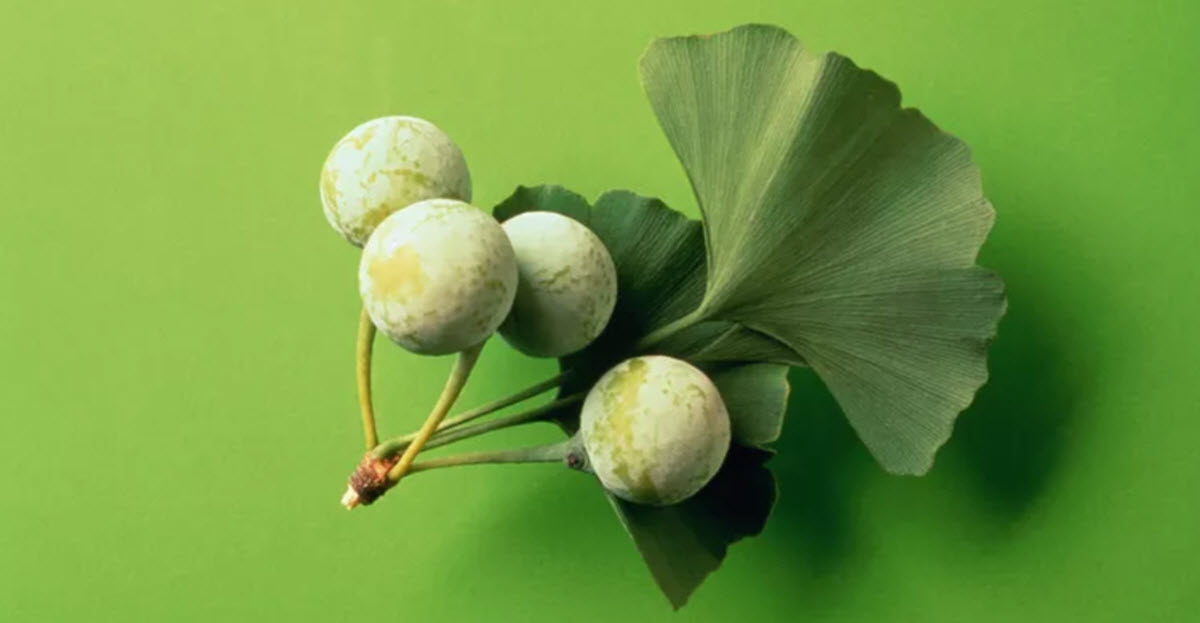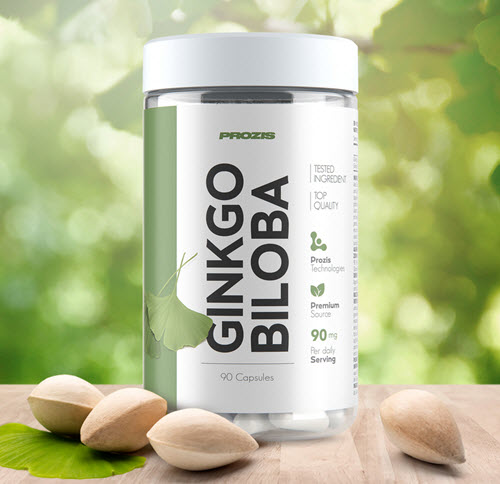Ginkgo biloba is a large tree native to China, where it has been cultivated for a very long time. In China, Japan and on the Korean peninsula, there is a strong association between this species and both Buddhism and Confucianism, and Ginkgo biloba trees have been planted on sacred sites in this region since ancient times. Some of the oldest specimens growing at temples are believed to have been there for at least 1,500 years.

Ginkgo biloba also has a long history of being used for food and included in folk medicine in this region. In Chinese culture, there is a also a tradition of viewing ginkgo biloba as an aphrodisiac.
The first recorded use of ginkgo biloba in folk medicin is from 15th century China.
Ginkgo biloba is the only extant species in the genus Ginkgo and in the whole division Ginkgophyta. The other members of this division were extinct a long time ago.
Ginkgo biloba is sometimes referred to as a “living fossil” since fossilized remains of this species, formed by threes that grew 270 million years ago, are extremely similar to today´s Ginko biloba trees.
English name
In English, this tree is called Maidenhair tree, but the scientific name Ginkgo biloba is also widely used in English texts.
The leaves of the Ginkgo biloba tree resemble some of the pinnae of the famous Maidenhair fern (Adiantum capillus-veneris), hence the English name Maidenhair tree.
10.6 billion DNA nucleobase “letters”
In 2016, Chinese researchers published a draft genome of Ginkgo biloba. This showed that the species have a large genome of 10.6 billion DNA nucleobase “letters”. (The human genome consists of 3 billion.)
For more information:
Guan, Rui; Zhao, Yunpeng; Zhang, He; Fan, Guangyi; Liu, Xin; Zhou, Wenbin; Shi, Chengcheng; Wang, Jiahao; Liu, Weiqing (1 January 2016). “Draft genome of the living fossil Ginkgo biloba”. GigaScience. 5 (1): 49. doi:10.1186/s13742-016-0154-1. ISSN 2047-217X. PMC 5118899. PMID 27871309.
A remarkable tree that shows little effects of aging
In 2020, a Chinese study of gingko trees up to 667 years old highlighted how these trees show little effects of aging. They continue to grow and display no genetic evidence of gradual deterioration of functional characteristic.
For more information:
Li Wang, Jiawen Cui, Biao Jin, Jianguo Zhao, Huimin Xu, Zhaogeng Lu, Weixing Li, Xiaoxia Li, Linling Li, Eryuan Liang, Xiaolan Rao, Shufang Wang, Chunxiang Fu, Fuliang Cao, Richard A. Dixon, and Jinxing Lin. “Multifeature analyses of vascular cambial cells reveal longevity mechanisms in old Ginkgo biloba trees” PNAS January 28, 2020 117 (4) 2201-2210; first published January 13, 2020.
Gingko in food
 The gametophytes inside the seeds of a ginkgo biloba tree are rather similar to nuts and are eaten in many parts of Asia. In China, ginkgo biloba gametophytes are often included in congee made for celebrations, such as weddings and the Chinese New Year. Congee is a type of rice gruel or porridge, which can be served as a side dish or as a meal on its own, depending on what you add to the rice. During the Chinese New Year celebrations, congee with gingko is typically served as a part of the vegetarian dish “Buddha´s Delight”.
The gametophytes inside the seeds of a ginkgo biloba tree are rather similar to nuts and are eaten in many parts of Asia. In China, ginkgo biloba gametophytes are often included in congee made for celebrations, such as weddings and the Chinese New Year. Congee is a type of rice gruel or porridge, which can be served as a side dish or as a meal on its own, depending on what you add to the rice. During the Chinese New Year celebrations, congee with gingko is typically served as a part of the vegetarian dish “Buddha´s Delight”.
In Japan, cooked ginkgo seeds – which ware called ginnan in Japanese – are a popular addition to eat alongside other dishes. They are also often included in chawammushi, an egg custard dish with savory ingredients served hot or cold.
In Thailand, ginkgo seeds combined with boiled coconut flesh is served as a dessert.
Use of ginkgo biloba in contemporary alternative medicine
Today, ginkgo biloba leaf extract is marketed as a dietary supplement world wide and used in certain alternative therapies.
Ginkgo biloba and cognitive function
It is frequently claimed to promote cognitive function (includng memory and attention), allthough no such effect has been scientifically proven.
Find out more:
- Laws KR, Sweetnam H, Kondel TK. Is Ginkgo biloba a cognitive enhancer in healthy individuals? A meta-analysis. Human Psychopharmacology: Clinical and Experimental. 2012;27(6):527-533.
Does gingko biloba prevent or slow the onset of Alzheimer?
Ginkgo biloba extract has been studied for its role in preventing or slowing the onset of Alzheimer’s disease. Results have been mixed.
Find out more:
- Weinmann, S., Roll, S., Schwarzbach, C. et al. Effects of Ginkgo biloba in dementia: systematic review and meta-analysis. BMC Geriatr 10, 14 (2010).
- Cooper, C; Li, R; Lyketsos, C; Livingston, G (September 2013). “Treatment for mild cognitive impairment: systematic review”. British Journal of Psychiatry (Systematic review). 203 (3): 255–264. doi:10.1192/bjp.bp.113.127811. PMC 3943830. PMID 24085737.
Phytochemicals found in ginkgo
Dried ginkgo biloba leaves have been shown to contain many different types of phytochemicals, including:
- Flavonoid glycosides (such as myricetin, kaempferol, quercetin and ginkgolides)
- Phenolic acids
- Proanthocyanidins
- Terpene trilactones
What are ginkolides?
Ginkgolides are biologically active terpenic lactones present in Ginkgo biloba. There are several types of ginkgolides, of which the most aboundant one in Ginko biloba bark is ginkolide A.
The class of ginkgolides was first isolted from the tree in 1932, and it took until 1967 before structural elucidation was accomplished.
For more information:
- Stromgaard, K.; Nakanishi, K. (2004). “Chemistry and Biology of Terpene Trilactones from Ginkgo Biloba”. Angew. Chem. Int. Ed. 43 (13): 1640–58. doi:10.1002/anie.200300601. PMID 15038029.
- Maruyama, M.; Terahara, A.; Itagaki, Y.; Nakanishi, K. (1967). “The ginkgolides. I. Isolation and characterization of the various groups”. Tetrahedron Letters. 8 (4): 299–302. doi:10.1016/S0040-4039(00)71538-3.
What are bilobalide?
Bilobalide is a biologically active terpenic trilactone present in Ginkgo biloba. It is one of the main constituents of the terpenoids found in Ginkgo biloba leaves, and can also be found in very small amounts in the roots of the tree.
For more information about the possible neuroprotective effects of bilobilade:
- Defeudis FV (2002). “Bilobalide and neuroprotection”. Pharmacological Research. 46 (6): 565–8. doi:10.1016/S1043-6618(02)00233-5. PMID 12457632.
- Kiewert C, Kumar V, Hildmann O, Hartmann J, Hillert M, Klein J (2008). “Role of glycine receptors and glycine release for the neuroprotective activity of bilobalide”. Brain Research. 1201: 143–50. doi:10.1016/j.brainres.2008.01.052. PMID 18325484.
Allergy warning
Male Ginkgo biloba trees produce pollen which can cause allergic reactions. They have an OPALS allergy scale rating of 7 out of 10. Female trees produce no pollen and have an OPALS allergy scale rating of 2 out of 10.
For more information: Ogren, Thomas Leo (2000). Allergy-Free Gardening. Berkeley, California: Ten Speed Press. p. 112. ISBN 978-1-58008-166-5.
Gingko biloba leaves and the sarcotesta also contains gingkolic acids which are known to be highly allergenic.
Bilobol warning
Gingko biloba leaves and the sarcotesta contain bilobol, a substance similar to the urushiols present in the plant poison ivy. If you have had a strong allergic reaction to poison ivy in the past, caution against gingko biloba is warranted. In Germany, the levels of bilobol in pharmaceutical preparations are not allowed to exceed 5 ppm.
Poison warning (gingkotoxin)
If the gametophyte of the Ginkgo biloba seed is ingested in large quantities over an extended period, poisoning can occur. The poison is ginkgotoxin (4′-O-methylpyridoxine) is a neurotoxin naturally occurring in Ginkgo biloba.
Gingkotoxin is an antivitamin (a substance that counteracts a vitamin) and it is structurally related to vitamin B6 (pyridoxine).
Among other things, ginkgotoxin can induce epileptic seizures.
You can find out more in our article about ginkgotoxin.
Other warnings
Ginkgo biloba ingestion can have undesirable effects for individuals with blood circulation disorders and for those taking anticoagulant medication or antiplatelet medication (such as aspirin)..
